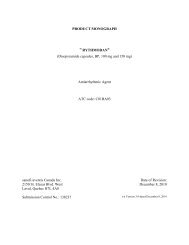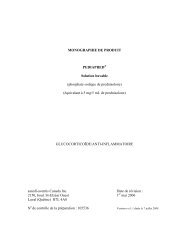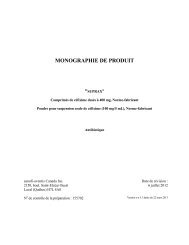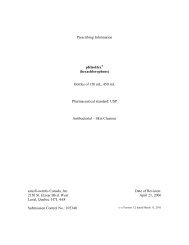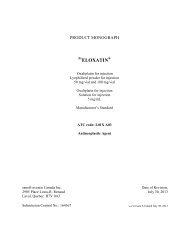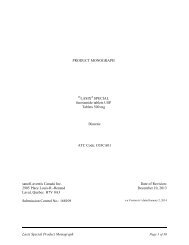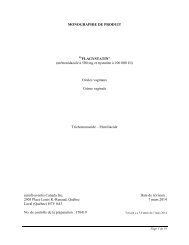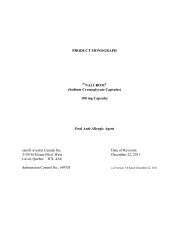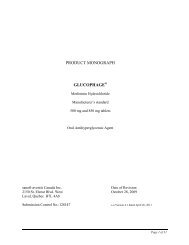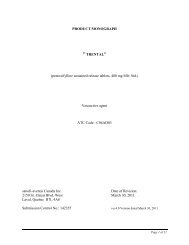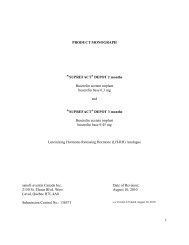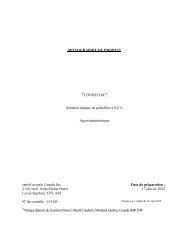Apidra (insulin glulisine) - Sanofi Canada
Apidra (insulin glulisine) - Sanofi Canada
Apidra (insulin glulisine) - Sanofi Canada
You also want an ePaper? Increase the reach of your titles
YUMPU automatically turns print PDFs into web optimized ePapers that Google loves.
TOXICOLOGY<br />
Single and Repeated Dose Toxicity<br />
Single- and repeated-dose toxicity studies were conducted in mice, rats and dogs in order to<br />
predict the safety profile for the therapeutic use of <strong>insulin</strong> <strong>glulisine</strong> in humans; all studies used<br />
normoglycemic animals. After a single injection of <strong>insulin</strong> <strong>glulisine</strong>, the approximate LD50 was<br />
>1000 U/kg in rats and mice and 40 U/kg in dogs. After repeated once daily subcutaneous<br />
injection of <strong>insulin</strong> <strong>glulisine</strong>, the No Observable Adverse Effect Level (NOAEL) in rats were 50<br />
U/kg after 1 month and 5 U/kg after 6 months. The NOAEL in dogs were 1 U/kg in both the 1month<br />
and 6-month studies.<br />
The toxicological profile of <strong>insulin</strong> <strong>glulisine</strong> was limited to the effects resulting from excessive<br />
hypoglycemia attributed to the exaggerated pharmacodynamic action of the compound after high<br />
doses in normoglycemic animals. Repeated-dose toxicity studies in rats and dogs did not reveal<br />
any unexpected findings different from human regular <strong>insulin</strong>.<br />
Insulin <strong>glulisine</strong>-related effects in toxicity studies were dose-dependent, reversible and restricted<br />
to toxic dose levels. Clinical observations and pathological findings obtained in these studies<br />
were similar or comparable to those in human beings observed after hyper<strong>insulin</strong>emia/<br />
hypoglycemia. In some cases, excessive hypoglycemia caused the deaths of animals. These<br />
findings in healthy, non-diabetic animals are not indicative of any specific toxicity on <strong>insulin</strong><br />
<strong>glulisine</strong> in patients, where it is used for controlled glucose-lowering effects at therapeutic doses.<br />
Carcinogenesis<br />
In Sprague Dawley rats, a 12-month repeat dose toxicity study was conducted with <strong>insulin</strong><br />
<strong>glulisine</strong> at doses of 2.5, 5, 20 or 50 U/kg twice daily (dose resulting in an exposure equivalent to<br />
approximately 26, 54, 258, 662 times the human Cmax at the average human dose, respectively).<br />
The incidence of mortality increased dose dependently in 2x20 and 2x50 U/kg <strong>insulin</strong> <strong>glulisine</strong><br />
or IU/kg human <strong>insulin</strong> treated groups respectively. Generally, males were more severely<br />
affected than females and mortality at the comparable dose levels was always higher in the<br />
human <strong>insulin</strong> treated groups.<br />
In this study, the effects of <strong>insulin</strong> <strong>glulisine</strong> on cellular proliferation in mammary glands were<br />
evaluated using Ki-67 immunohistochemistry. There were no significant differences in<br />
mammary cell proliferation between <strong>insulin</strong> <strong>glulisine</strong>, regular human <strong>insulin</strong> and control groups.<br />
Page 33 of 61



